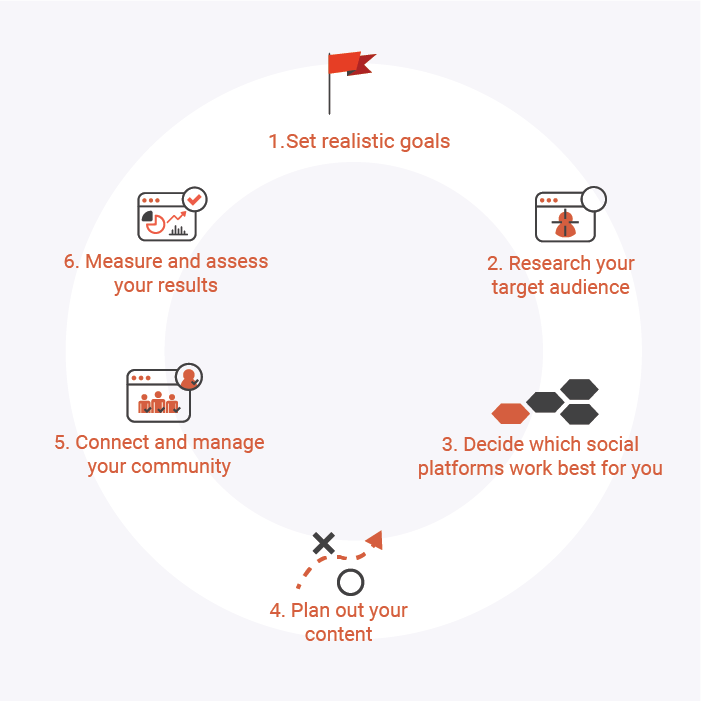It’s news to no one that having an online presence is a necessity for any business and brand in today’s digital age. Out of all the channels and tools that can help you build a strong digital marketing strategy for your business, social media has the most eyeballs and ways of keeping users engaged.
Just take a look at the stats:
- In 2021, over 4.26 billion people globally were on social media. That’s over half of the population and this number is projected to increase to almost 6 billion by 2027.
- According to Search Engine Watch, 71% of consumers are more likely to base their buying decisions on what they’ve seen on social media.
Yet many social media experts will tell you it’s not about having a profile on any and every network. There’s a lot that goes into knowing, reaching and engaging with your target audience. In other words, you need a specialized social media strategy that serves your business goals and complements your business’ overall digital marketing strategy.
In this article, we’ll break down the ins and outs of building a social media strategy.
- What is a social media strategy?
- The differences between a social media marketing, content and engagement strategy
- 6 steps for building a social media strategy
What is a social media strategy?
A social media strategy outlines your social media goals, tactics and the metrics you will be using to track your performance. It is the plan that guides how you create and post content, and engage on social media.
Tactically, this can include everything from resource allocation, establishing content and engagement guidelines, developing campaigns, and determining when and how frequently you will post.
While this might seem overwhelming, it does not have to be complicated. It is best to keep your social media strategy simple and specific to your brand. With meaningful data tracking, keep in mind that you can keep tweaking and gradually building upon your strategy to make it more effective over time.
Social media marketing, content and engagement
It may help to think of social media strategy broken up into three distinct areas:

Social media marketing
A social media marketing strategy is your starting point and throughline in directing your social media activities. It involves bringing together foundational elements like your target audience and brand identity before developing campaigns and producing content. Author and digital strategist Julie Atherton calls this approach “ABC” for an audience, brand, and campaign.
In the age of Tiktok, there’s a real temptation to be reactive to what is trending. Having a strategy that underpins everything you do will keep you grounded and help you determine what makes sense for your business.

Content
Content is where the rubber meets the road in engaging your audience, representing your brand and tracking your performance. A content strategy focuses on formatting, production and outputs.
Content creation requires planning and research into the campaigns, topics, and formats that will most effectively reach and engage your audience. You will also have to consider your messaging, tone, and the specifications you will be using for each social network. Lastly, tracking how your posts perform and analyzing the data serves as crucial information to optimise your content (i.e. telling you what’s working and what’s not)

Engagement
Social media offers a completely different and exciting way for brands to engage with their audience and customers. They provide a two-way street for businesses to promote their products and services, and for customers to publicly interact and influence how brands present themselves and what they offer.
An engagement strategy is how you manage your community and grow your following. While certainly related, this is not to be confused with engagement as a metric, referring to the number of times people took an action on your post. These include clicks, shares, comments, or reactions. Social environments require responsible and responsive customer service and thoughtful ways of generating interactions. What are some unique valuable offerings you can share with your social media audience? Some examples might include educational content, free downloadable digital products, or giveaway competitions.
What are the steps for building a social media strategy?
- Set realistic goals
Taking the time to define specific and achievable goals will have a big payoff in guiding your strategy, budget, and day-to-day activities. It helps to start with a big-picture objective that answers why your business is active on social media and what you want to achieve.
According to the 2021 Sprout Social Index, the most common goals for social were increasing brand awareness (58%) and increasing community engagement (41%). Others include generating leads and sales, learning more about your target audience, or growing your following. While you may want to achieve all of these, less is more, as each will involve different tactics.
From there you will want to outline your goals according to their relevant metrics or Key Performance Indicators (KPIs), your resources, and your timeframe. Using the S.M.A.R.T framework is always helpful here.
- Learn about your target audience
To understand who your target audience is and what they want, start by defining their key demographics (age, gender, income, interests, etc.). From here, you’ll want to spend time doing market research through online surveys or focus groups. Defining a buyer profile and having buyer insights will help you to create a buyer persona — a picture of your ideal customer. While the aim is to narrow down, you can have more than one persona, which will allow you to capture different demographics, insights, and needs.
- Decide which social platforms work best for you
As we’ve covered, you want to avoid being present on all social platforms for the sake of it. How do you choose the best channels to reach your audience? Research which key networks your target audience is spending the most time. It will also depend on what most intuitively suits your business and the type of content your produce. For example, Instagram is popular among younger audiences and is a great visual platform to showcase your products and connect with influencers. However, if your ideal customers are industry professionals, you would benefit more from LinkedIn, as a platform that provides businesses with a way to connect with both B2B and B2C communities.
- Plan out your content
For each social platform you choose, you’ll want to create a separate yet coordinated plan for your content. Each platform has its own tone, so it’s important to determine the tone of your brand and how you want to speak on each (i.e. formal or informal, sense of humour or more serious?). Some other helpful tips include coming up with content themes or buckets; creating a content calendar, and scheduling your content to take advantage of optimum days and times for networks and ensure you’re keeping up with the pace of social media with consistent posts.
- Connect with and manage your community
Connections on social media can lead to great communities that build awareness and engagement with your brand. But this kind of community takes time and nurture, and the key to building it is to be responsive. Responding to queries and comments quickly, with the aim of being helpful and positive in a way that fosters human-to-human connection will not only help you avoid a crisis but will nurture trust. Another tool for connecting with your community is to ask questions and seek feedback or input on a product through polls or surveys.
- Measure and assess your results
Take full advantage of the tools social media platforms offer to help businesses track analytics. You’ll not only want to see how much traffic your social media accounts drive to your website but what posts people are engaging with the most. You’ll be able to identify trends related to particular topics and content types, and what generates the most interest.
Once you gather these insights, it’s time to reassess what’s working and what isn’t, adjusting your strategy and setting renewed goals across key metrics (e.g. new followers, interactions, visits to your website).
Sources
https://blog.hubspot.com/marketing/social-media-strategy-for-your-business
https://digitalmarketinginstitute.com/blog/social-media-strategy
https://digitalmarketinginstitute.com/resources/podcasts/podcast-016-practical-social-media-strategy-julie-atherton
https://www.forbes.com/sites/goldiechan/2022/03/28/how-to-think-intelligently-about-social-media-strategy-in-2022/?sh=6d8b8097919c
https://www.searchenginewatch.com/2020/11/20/how-social-media-influence-71-consumer-buying-decisions/






